Exploring Faerøer
Wooden houses with grass roofs on impressive fjords
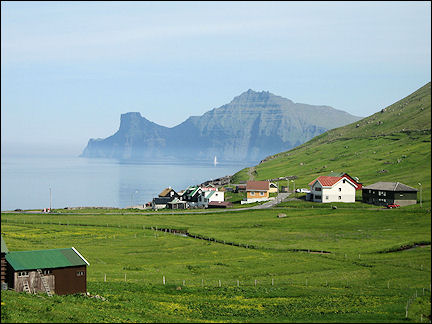
|
Not many people visit the Faerøer Islands (sheep islands), but they make for an excellent stopover when you're taking the ferry from Denmark to Iceland. Except for the ubiquitous sheep, you'll find villages with wooden houses, sometimes still with grass roofs, along fjords. The mountainous green landscape is impressive and often ends in steep cliffs by the sea, on which countless colonies of birds nest, undisturbed by predators or people.
Travelogue & photos: Willem & Christiane Mosselmans-De Coster
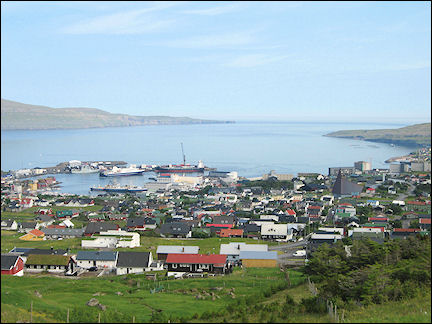
|
The ferry Norrona arrives around 10:30 PM in the port of Tórshavn, the capital of Faerøer. Tórshavn is located in the southeast of Streymoy, the largest of the eightteen Faerøer Islands.
We boarded the ferry with our car yesterday afternoon in Hanstholm in the north of Denmark. The trip on a calm sea, practically without waves, was uneventful and relaxing.
Streymoy
Seabirds nest high up on the steep rocks
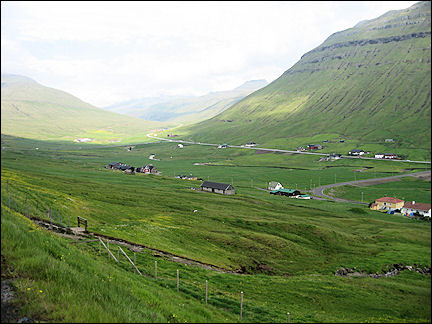
|
In Tórshavn, even though it's a small town, it's hard to find your way. After our arrival we had problems finding our hotel, even as it wasn't far from the port. And this morning we find ourselves going in circles and ending up at the port every time.
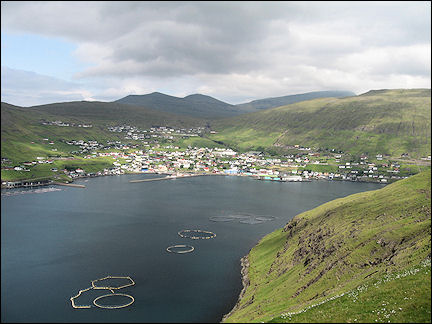
|
Eventually we find, after asking several times, the ring and the right lane to get to Vestmanna in the western part of Streymoy. The landscape is beautiful, with mountains and valleys. It reminds us somewhat of the Lofoten, an archipelago north-west of Norway.
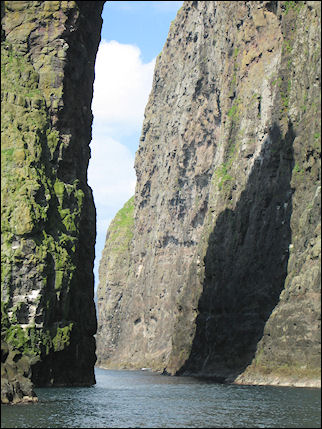
|
In Vestmanna we board a boat for a tour of the bird rocks where we should be able to see Altlantic puffins. We leave in a fast motorboat at 2 PM. There are many people, I think the boat is filled to capacity.
Because we will pass between high, steep rocks, through sometimes very narrow passages, the guide hands us yellow hard hats. He tells us in English about the different kinds of seabirds that we'll see here: Atlantic puffins, Northern fulmars, and Northern gannets.
There are many breeding grounds high up on the rocks and masses of birds with their young. We see so many beautiful birds, unfortunately often flying, so hard to take pictures of. Even the Atlantic puffins, which we really wanted to see, fly back and forth over our heads.
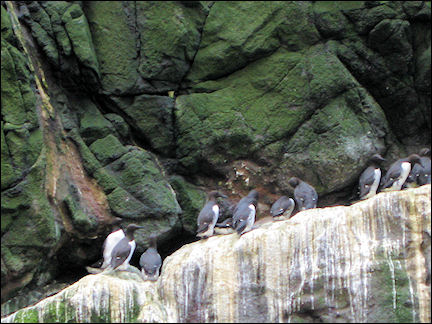
|
The wonderful tour lasts for two hours, then we head back at full speed to the port of Vestmanna, because another group of interested people is waiting. Even though it's hot, we feel cold because of the speed with which the boat returns to the port.
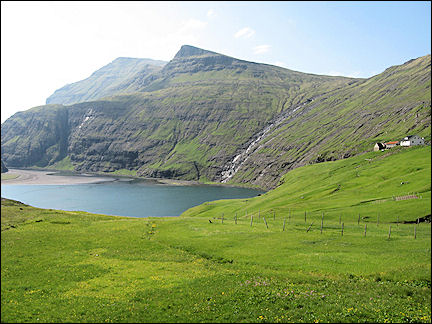
|
We continue on to the north of Streymoy and make a stop to visit a black church with white spire and grass-roof in Hvalvik. Unfortunately it's closed. We drive to Saksun, a picturesque town in the northwest of the peninsula that should be worth visiting.
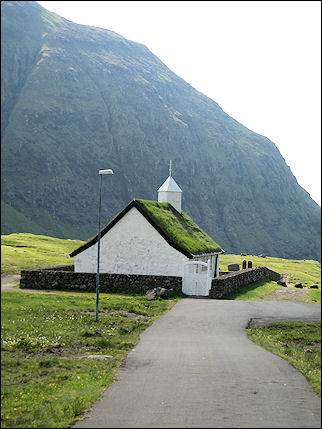
|
Saksun lies at the foot of a fjord, surrounded by rather high mountains, and it also has a small church. We will see this type of small churches throughout our trip. Even villages with only a few houses all appear to have their own church. But this one is also closed. It's getting late and we have to drive all the way back, so we decide to pass Tjornuvik by. If we want to, we can visit here tomorrow after our tour of Eysturoy.
We return to Tórshavn via Hvalvik and Kollafjordur; we stay on road 54 along the coast to stop in Hoyvik and walk to the Hoyvikar Kirkja. This church is also closed. The Hoyvikar Kirkja, remarkably bigger than the others, is visible from afar because of its high location, and is built in a modern style.
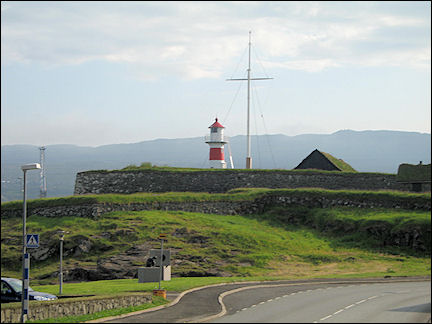
|
We return to our hotel to freshen up for dinner. Before we go look for a restaurant in Tórshavn we wander around in the town and walk to the lighthouse, where we have a great view of the port.
Eysturoy
Colorful villages at the edges of fjords
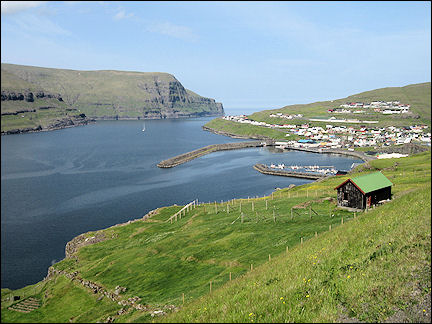
|
It's sunny with a pretty cloud now and then, a little wind, but it's warm. Today we drive to Eysturoy, the second largest island of the Faerøer, connected to Streymoy by the North Atlantic Ocean Bridge.
Again we take road #10 to Kollafjordur until we hit a traffic jam and everyone turns. What should we do? A friendly man walks up to us and explains that the road is closed for three days because of construction work and that we should go back and take the old road through the mountains to Kollafjordur. He points out everything on an extremely small map.
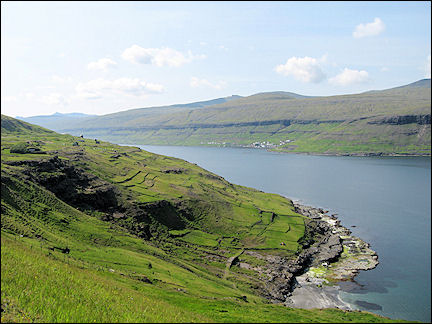
|
And so we drive on a mountain road, an excellent one with two lanes and with great views. There's a little more traffic than yesterday, up to Hvalvik where we cross the bridge over the ocean. Immediately afterwards the road begins to climb, and we have wonderful views of lower lying Streymoy.
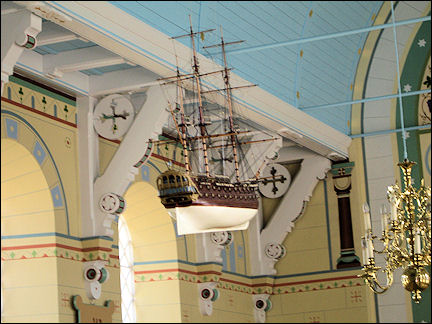
|
We drive north to Eldi, a village with a view of the Sundini, a sound in the northwest of the island of Eysturoy. We take a short walk and visit a beautiful white church with black roof. Remarkable about the interior are the chandeliers and sailingboats that are suspended from the ceiling. This is also something we will see again.
Here, on the north coast, at Eldi, there are two wonderful basalt columns: Faroese Risin ("giant") & Kellingin ("witch"). The giant is a 71 meters high column, of the two the farthest removed from the coast, and the witch is still tall with her 68 meters, standing near the coast with "spread legs". They are clearly visible from the road to Tjornuvik on Streymoy on the other side, as we will find out later today.
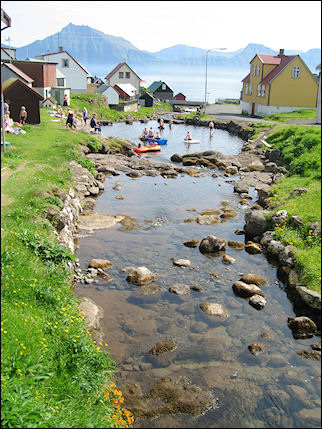
|
We continue on to Gjogv, which boasts the highest mountain of the Faerøer: Slættaratindur, at 882 meters. We drive along high mountains, pretty valleys and villages far below us on the fjord shores. Every now and then we meet sheep or geese crossing the road - and they have right of way!
Gjogv is a hamlet located on the northeast coast of Eysturoy. Just before we arrive, we see children play happily in a river, while their parents get a tan keeping an eye on them. It's hard to believe what we see: this is the north, right? It looks like a Belgian sea resort.
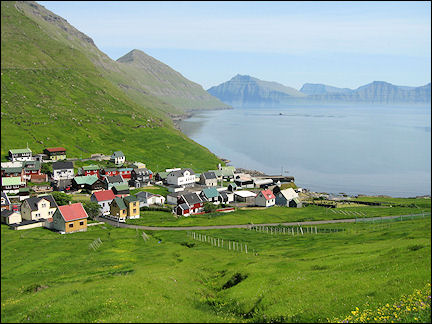
|
We turn and descend via Funningur and continue on our route on the island, via Funningsfjordur to Leirvik, but first we drive north to Elduvik. Again a colorful hamlet at the end of a fjord, so we return on our way south to Leirvik.
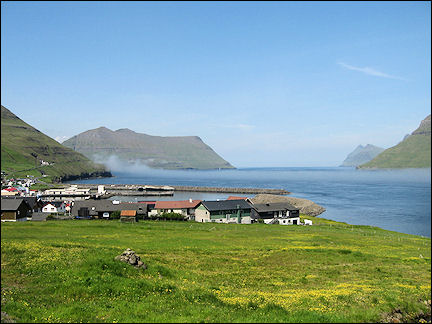
|
Leirvik is a larger town with a port, on Eysturoy's east coast. It's possible to continue on via a submarine tunnel to Klaksvik on Bordoy, another of the Faerøer Islands. We skip it and visit the village.
There are supposed to be remains from the Viking Era (± 900) in Leirvik. We walk in - what seems to us to be - a memorial field for fishermen who perished at sea; then to the church, which is large, in sharp contrast with the other churches we've seen on Faerøer. The building is painted white and has a black roof. The interior is frugal, but beautiful.
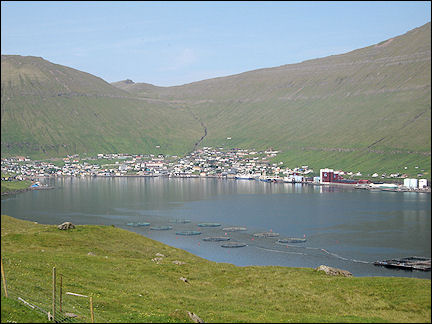
|
And again north after leaving Leirvik, to Fuglafjordur. In the sea are salmon nurseries. We turn and drive on to Runavik, Toftir and Nes on Eysturoy's south coast.
Nes again is a destination at the end of a dead end; at the moment it's obscured by a thick fog. We don't have much in the way of view, so we turn and drive back. A little further on the road, the fog is gone.
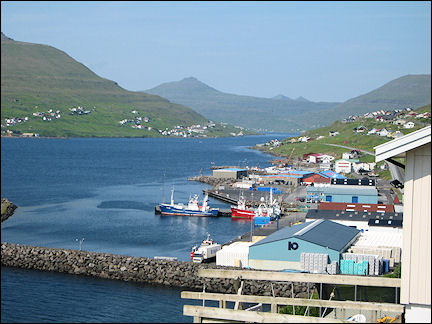
|
We arrive in Toftier, where we explore a little. It is a nice, colorful sea town with a modern church. We don't go inside, but return to Runavik.
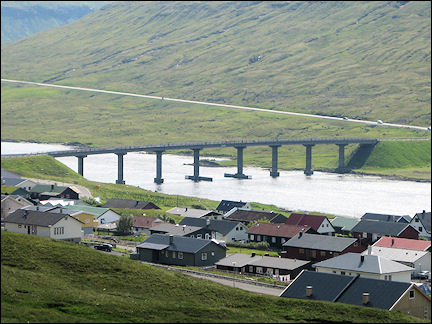
|
Runavik is larger than most villages we already saw. We continue on northward on road #10, cross the North Atlantic Ocean Bridge and then are back on Streymoy, where we drive to Tjornuvik, the town in the north that we missed yesterday.
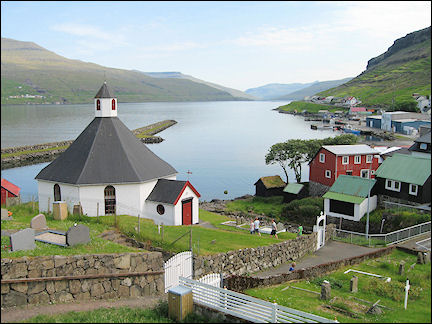
|
We stop near Haldarsvik. Here we have a great view of the village and the bay. This village has the only octagonal church on Faeroer and it's clearly visible from our elevated position.
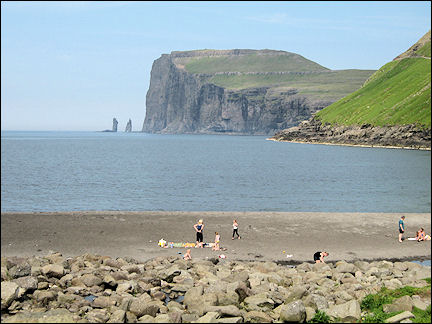
|
A little later we arrive in Tjornuvik, again at the end of a fjord, and again people are playing, sunbathing and having fun in the sea. From here we again see Risin, the giant, and Kellingin, the witch. There's a pretty wooden church, but it's closed.
We drive back on the same elevated, scary road and near Eldi on the other side of the water, more from close up now, we see the two wonderful basalt columns Risin and Kellingin rise up from the sea.
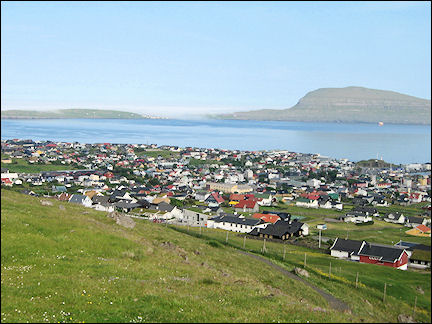
|
We stop to admire the landscape and are welcomed by a dozen of sheep, who stare at us in amazement that we have dared to intrude in their territory.
We drive back to Tórshavn, again taking the mountain road, and enjoy the views, the many birds and the sheep walking with their offspring. We freshen up and take a walk in the town. Tomorrow we leave for Iceland.
Kirkjubøur
Black houses with red windows and grass roofs
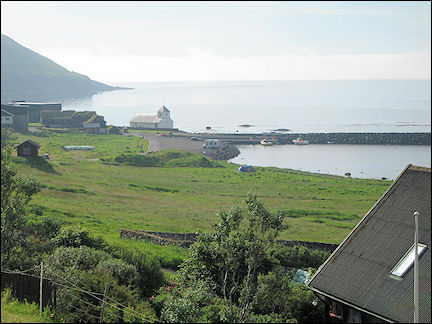
|
After breakfast we leave for Kirkjubøur in the south of Streymoy, on Hestsfjodur. There is a light fog and for a while there a drizzle. We drive on road #54, crossing the mountains to Kirkjubøur. When you get out of the last turn, high up above the sea, the view is breathtaking, it's very impressive.
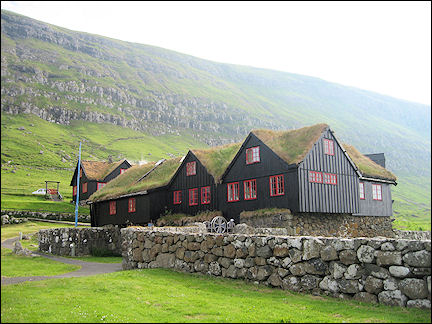
|
This beautiful port town has remarkable painted wooden buildings, most of them black houses with red windows, of with a grass roof or one painted green. The church is white with a black roof and it has a nice gate with stained glass windows. It's picture postcard pretty.
We return to Tórshavn, where we take a walk in Vidarlundin, the city park. The plants and trees look neglected. After a while we feel some drops and because we didn't bring umbrellas or raincoats, we go back to our car.
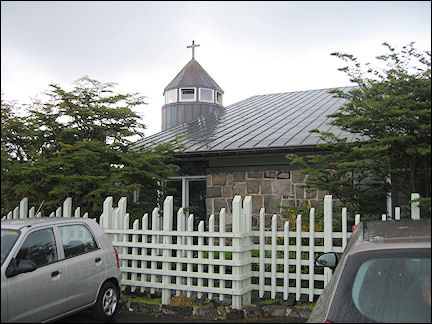
|
We visit the only Catholic church on predominantly Lutheran Faerøer. Our map helps us find it quickly. It is a modern building, with pretty windows, but a frugal interior. Except for a wooden sculpture of the Virgin Mary with child, there is a sailingboat suspended from the ceiling and by the entrance is a statue of St. Francis.
We drive to the port and get in line for the ferry to Iceland.